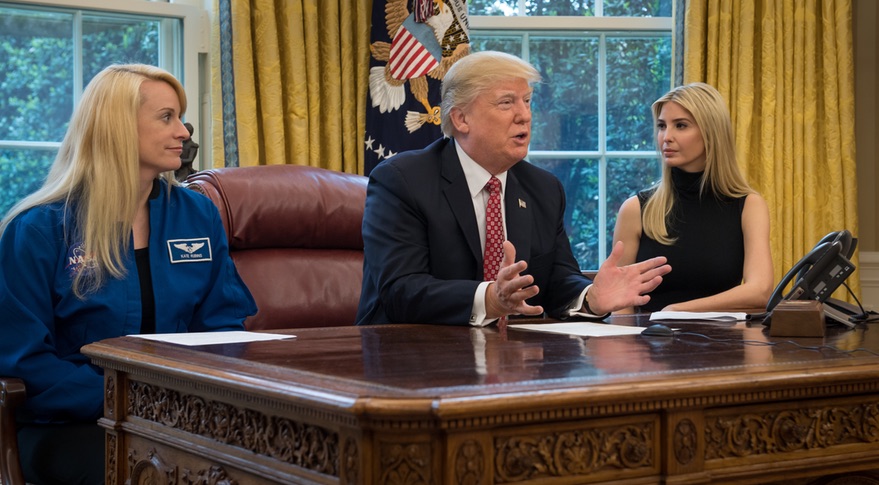Trump's Exuberance for Mars Faces Technical and Fiscal Challenges

WASHINGTON — In a conversation with NASA astronauts on the International Space Station April 24, President Donald Trump called for a human mission to Mars by the end of his second term in 2024, a timeframe most in the industry do not consider feasible.
Trump discussed his Mars exploration aspirations in a 20-minute conversation with astronauts Peggy Whitson and Jack Fischer, currently on the station. Trump, sitting in the Oval Office at the White House, asked the astronauts about when NASA would be ready to send humans to the planet. "What do you see a timing for actually sending humans to Mars?" he asked.
"Well, I think as your bill directed, it will be approximately in the 2030s," responded Whitson, referring to a NASA authorization act that Trump signed into law March 21. That bill included language requiring NASA to contract with an "independent, non-governmental systems engineering and technical assistance organization" to study the feasibility of a human Mars mission in 2033.
"Unfortunately, spaceflight takes a lot of time and money, so getting there will require some international cooperation to get it to be a planet-wide approach in order to make it successful, just because it is a very expensive endeavor," Whitson said. "But it so worthwhile doing." [Watch Trump Peggy Whitson on Her Spaceflight Record]
Trump, though, said he wanted a faster timeline. "Well, we want to try and do it during my first term or, at worst, during my second term," he said. "So we'll have to speed that up a little bit, okay?"
He reiterated an accelerated timeframe later in the discussion. "I'm very proud that I just signed a bill committing NASA to the aim of sending America astronauts to Mars," he said, again referring to the authorization act. "So we'll do that. I think we'll do it a lot sooner than we're even thinking."
NASA's current plans, independent of the authorization act language, do not project a human mission to Mars orbit any earlier than 2033. In recent weeks, agency officials unveiled plans to build up a Deep Space Gateway, a habitat in cislunar space, in the 2020s, followed by a Deep Space Transport that would undergo a one-year test in cislunar space in the late 2020s before being used for a human mission to orbit Mars.
Breaking space news, the latest updates on rocket launches, skywatching events and more!
Accelerating that schedule even by a few years would run into issues with development of both the spacecraft needed for such missions and key technologies. NASA has previously stated they need to operate the ISS through 2024 in order to test life support systems needed for Mars missions as well as retire other biomedical risk issues for those missions.
An accelerated schedule would also require a sharply increased budget for the agency's exploration programs. However, a fiscal year 2018 budget blueprint document, released by the White House March 16, offered $3.7 billion for the Space Launch System, Orion and ground systems, similar to what those programs collectively received in 2016. Congress has not yet finalized a fiscal year 2017 appropriations bill, nearly seven months into the fiscal year.
A more detailed fiscal year 2018 budget proposal is expected to come out in mid-May. That document may also disclose what decision NASA and the White House have made about flying a crew on the first SLS/Orion mission, Exploration Mission 1. That mission is currently set to launch in late 2018 without a crew, although a recent report by NASA's Office of Inspector General concluded it was likely the mission would be delayed regardless of any decision to add astronauts to the flight.
The call was primarily intended to celebrate Whitson's setting a new U.S. cumulative spaceflight record of 534 days in space, breaking the mark set by Jeff Williams in 2016. President Trump was joined in the Oval Office by his daughter Ivanka, who holds the title of assistant to the president; and by Kate Rubins, a NASA astronaut who flew on the space station in 2016.
Ivanka Trump, in her comments, sought to emphasize science, technology, engineering and mathematics (STEM) education and the role of NASA to promote that research. She also discussed STEM education at the National Air and Space Museum March 28 with Secretary of Education Betsy DeVos and NASA astronaut Kay Hire. That appearance came after the 2018 budget proposal, which included plans to defund the NASA Office of Education.
President Trump did not bring up any near-term space policy issues, including the nomination of a new NASA administrator or plans to reestablish the National Space Council. At the end of the call, he asked Whitson and Fischer if they were ready to go to Mars. Both raised their hands.
"We are absolutely ready to go to Mars. It's going to be a fantastic journey getting there, and very exciting times, and all of us would be happy to go," Whitson said. "But I want all the young people out there to recognize that the real steps are going to be taken in a few years. And so by studying math, science, engineering, any kind of technology, you're going to have a part in that, and that will be very exciting."
This story was provided by SpaceNews, dedicated to covering all aspects of the space industry.

Jeff Foust is a Senior Staff Writer at SpaceNews, a space industry news magazine and website, where he writes about space policy, commercial spaceflight and other aerospace industry topics. Jeff has a Ph.D. in planetary sciences from the Massachusetts Institute of Technology and earned a bachelor's degree in geophysics and planetary science from the California Institute of Technology. You can see Jeff's latest projects by following him on Twitter.

